Welcome to the latest selection of recent top articles in the physica status solidi journals. Get a glimpse of our publication spectrum and visit our pages by clicking on any of the DOI links below.
Thermal conductivity of silicon nanowires: From fundamentals to phononic engineering [Review@RRL]
Gang Zhang and Yong-Wei Zhang
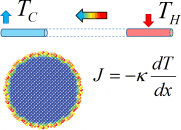 The thermal conductivity of silicon nanowires can be altered by introducing different phonon scattering mechanisms. These scattering mechanisms manifest themselves as the dominant ones only in a certain range of frequency regimes. The study to control and modify the phonon thermal conductivity of nanowires via manipulating their internal structure, composition and defects is referred by the authors as “phononic engineering”. Phononic engineering will provide an efficient and practically useful tool for controlling the thermal conductivity of nanomaterials.
The thermal conductivity of silicon nanowires can be altered by introducing different phonon scattering mechanisms. These scattering mechanisms manifest themselves as the dominant ones only in a certain range of frequency regimes. The study to control and modify the phonon thermal conductivity of nanowires via manipulating their internal structure, composition and defects is referred by the authors as “phononic engineering”. Phononic engineering will provide an efficient and practically useful tool for controlling the thermal conductivity of nanomaterials.
Phys. Status Solidi RRL (2013) DOI 10.1002/pssr.201307188
Silicene on hydrogen-passivated Si(111) and Ge(111) substrate [Rapid Research Letter]
Sebastian Kokott, Lars Matthes, and Friedhelm Bechstedt
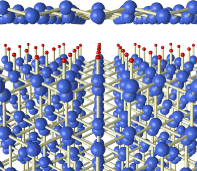 The growth of silicene, the graphene-like allotrope of silicon, is an unsolved challenge. As a favorable approach the silicene for-mation on a hydrogenated Si(111) or Ge(111) substrate is pre-dicted. Its stability and electronic properties are demonstrated by first-principles studies. The weak van-der-Waals interaction between silicene and substrates does not destroy its linear bands forming Dirac cones at the Brillouin zone corners. Only very small fundamental gaps are opened around the Fermi level.
The growth of silicene, the graphene-like allotrope of silicon, is an unsolved challenge. As a favorable approach the silicene for-mation on a hydrogenated Si(111) or Ge(111) substrate is pre-dicted. Its stability and electronic properties are demonstrated by first-principles studies. The weak van-der-Waals interaction between silicene and substrates does not destroy its linear bands forming Dirac cones at the Brillouin zone corners. Only very small fundamental gaps are opened around the Fermi level.
Phys. Status Solidi RRL (2013) DOI 10.1002/pssr.201307215
Hybrid polymer/inorganic nanoparticle blended ternary solar cells [Rapid Research Letter]
Seokhyun Yoon, Seung Jin Heo, and Hyun Jae Kim
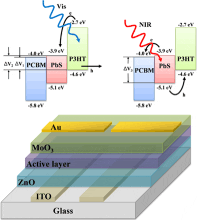 Hybrid polymer/inorganic nanoparticle blended ternary solar cells are reported by Yoon et al. These solar cells have an active layer consisting of PbS colloidal quantum dots (CQDs), poly (3-hexylthiophene) (P3HT), and [6,6]-phenyl-C61-butyric acid methyl ester (PCBM). The power conversion efficiency (PCE) was improved by incorporating PbS CQDs in the active layer of P3HT:PCBM-based organic solar cells. As the concentration of PbS CQDs in the hybrid solar cells was increased, PCE was also increased. This improvement resulted from improved charge transfer and also extended light absorption into the near-infrared. The PCE of the hybrid solar cells was 47% higher than that for reference organic solar cells on average under air mass 1.5 global illumination.
Hybrid polymer/inorganic nanoparticle blended ternary solar cells are reported by Yoon et al. These solar cells have an active layer consisting of PbS colloidal quantum dots (CQDs), poly (3-hexylthiophene) (P3HT), and [6,6]-phenyl-C61-butyric acid methyl ester (PCBM). The power conversion efficiency (PCE) was improved by incorporating PbS CQDs in the active layer of P3HT:PCBM-based organic solar cells. As the concentration of PbS CQDs in the hybrid solar cells was increased, PCE was also increased. This improvement resulted from improved charge transfer and also extended light absorption into the near-infrared. The PCE of the hybrid solar cells was 47% higher than that for reference organic solar cells on average under air mass 1.5 global illumination.
Phys. Status Solidi RRL (2013) DOI 10.1002/pssr.201307157
Reduced Coulomb interaction in organic solar cells by the introduction of inorganic high-k nanostructured materials [Original Paper]
Miriam Engel, David Schaefer, Daniel Erni, Niels Benson, and Roland Schmechel
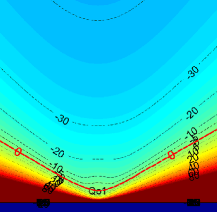 Engel et al. introduce a new concept to enhance the effective permittivity of organic semiconductor thin films by the integration of electrically insulating, nanostructured high-k materials. This concept is intended for application in organic photovoltaic cells. Using an analytical model the authors substantiate that an enhancement of the effective organic thin-film permittivity will reduce the Coulomb interaction in the organic layer, and as such will improve the charge carrier transport properties. This was experimentally verified by realizing first P3HT:PCBM:SrTiO3 nanoparticle test devices, which demonstrate an enhanced power conversion efficiency of ∼17% in comparison to a P3HT:PCBM reference de-vice.
Engel et al. introduce a new concept to enhance the effective permittivity of organic semiconductor thin films by the integration of electrically insulating, nanostructured high-k materials. This concept is intended for application in organic photovoltaic cells. Using an analytical model the authors substantiate that an enhancement of the effective organic thin-film permittivity will reduce the Coulomb interaction in the organic layer, and as such will improve the charge carrier transport properties. This was experimentally verified by realizing first P3HT:PCBM:SrTiO3 nanoparticle test devices, which demonstrate an enhanced power conversion efficiency of ∼17% in comparison to a P3HT:PCBM reference de-vice.
Phys. Status Solidi A (2013) DOI 10.1002/pssa.201228771
Excess carrier lifetime and strain distributions in a 3C-SiC wafer grown on an undulant Si substrate [Original Paper]
Masashi Kato, Atsushi Yoshida, Masaya Ichimura, and Hiroyuki Nagasawa
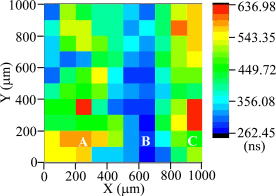 Kato et al. have used the microwave photoconductivity decay method (μ-PCD) to map the carrier lifetimes in 3C-SiC, epi-taxially grown on an undulant Si(100) substrate. The authors found that the carrier lifetimes in strained regions are shorter than those in other regions. From Raman spectroscopy and etch-pit distributions, they found that defects are present at higher concen-trations in the strained regions. In addition, the μ-PCD results depend on the measurement configuration (parallel or perpen-dicular), which may be attributed to high electrical conductivity in the directions parallel to stacking faults (SFs). These results suggest that for devices fabricated using such 3C-SiC wafers, ac-tive regions are required to be outside strained regions, and the anisotropic electrical conductivity due to SFs is required to be considered.
Kato et al. have used the microwave photoconductivity decay method (μ-PCD) to map the carrier lifetimes in 3C-SiC, epi-taxially grown on an undulant Si(100) substrate. The authors found that the carrier lifetimes in strained regions are shorter than those in other regions. From Raman spectroscopy and etch-pit distributions, they found that defects are present at higher concen-trations in the strained regions. In addition, the μ-PCD results depend on the measurement configuration (parallel or perpen-dicular), which may be attributed to high electrical conductivity in the directions parallel to stacking faults (SFs). These results suggest that for devices fabricated using such 3C-SiC wafers, ac-tive regions are required to be outside strained regions, and the anisotropic electrical conductivity due to SFs is required to be considered.
Phys. Status Solidi A (2013) DOI 10.1002/pssa.201329015
Atomistic origin of rapid crystallization of Ag-doped Ge–Sb-Te alloys: a joint experimental and theoretical study [Original Paper]
B. Prasai, M. E. Kordesch, D. A. Drabold, and G. Chen
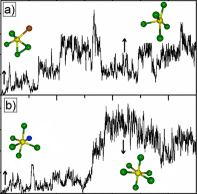 Experimental and theoretical studies of Ag-doped Ge1Sb2Te4 have re-vealed that the average Ge–Te bond length increases with Ag concentration, whereas the Sb–Te and Ag–Te bond lengths remain unchanged. The increase in the fraction of distorted octahedral Ge sites explains the net increase in Ge–Te bond lengths, and appears to be responsible for the faster crystallization of Ge–Sb–Te alloys caused by doping as confirmed by molecular dynamics simulations. Fur-thermore, the high fraction of Ag–Te suggests that Ag pre-fers bonding with Te to Ge and Sb. This study sheds light on the atomistic mechanism of rapid crystallization of GST alloys en-hanced by Ag doping.
Experimental and theoretical studies of Ag-doped Ge1Sb2Te4 have re-vealed that the average Ge–Te bond length increases with Ag concentration, whereas the Sb–Te and Ag–Te bond lengths remain unchanged. The increase in the fraction of distorted octahedral Ge sites explains the net increase in Ge–Te bond lengths, and appears to be responsible for the faster crystallization of Ge–Sb–Te alloys caused by doping as confirmed by molecular dynamics simulations. Fur-thermore, the high fraction of Ag–Te suggests that Ag pre-fers bonding with Te to Ge and Sb. This study sheds light on the atomistic mechanism of rapid crystallization of GST alloys en-hanced by Ag doping.
Phys. Status Solidi B (2013) DOI 10.1002/pssb.201349150
















